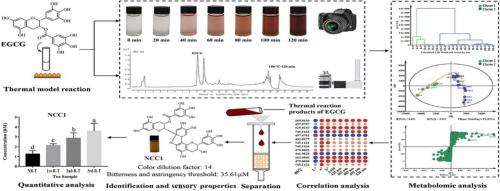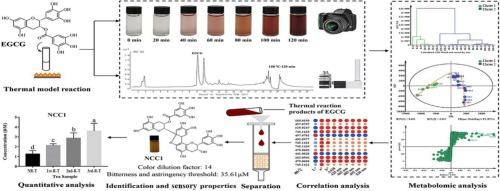由EGCG加热形成的新型颜色化合物的发现和鉴定:综合多光谱、感官评价、代谢组学和核磁共振
IF 9.8
1区 农林科学
Q1 CHEMISTRY, APPLIED
引用次数: 0
摘要
(−)-表没食子儿茶素没食子酸酯(EGCG)是茶中的主要儿茶素。然而,其在茶叶烘烤过程中转化为感官活性化合物的机制尚不清楚。基于lc - ms的代谢组学和多光谱分析发现,EGCG在高温加热过程中形成了多种新的颜色化合物(NCCs),这些化合物与颜色指数呈正相关。确定了关键的NCC1,其颜色稀释系数为14,苦味和涩味的味觉阈值为35.61 μM。研究了底物比、温度、时间和pH对NCC1含量的影响,发现(−)-表没食子儿茶素(EGC)参与了NCC1含量的形成。不同条件下NCC1含量范围为0.03 ~ 448.03 μM。不同烘烤时间茶叶中NCC1含量在1.25 ~ 3.59 μM之间。本研究为探索高温焙烧过程中茶中儿茶素形成感觉活性化合物的机理和评价其性质提供了基础。本文章由计算机程序翻译,如有差异,请以英文原文为准。


Discovery and identification of novel color compound formed from EGCG upon heating: Integrated multispectral, sensory evaluation, metabolomics, and nuclear magnetic resonance
(−)-Epigallocatechin gallate (EGCG) is the major catechin in tea. However, its transformation mechanisms into sensory-active compounds during tea roasting remain unclear. LC-MS-based metabolomics and multispectral analysis discovered a variety of novel color compounds (NCCs) formed from EGCG during high-temperature heating, and these compounds were positively correlated with color indexes. The critical NCC1 was identified, with a color dilution factor of 14 and taste thresholds for bitterness and astringency at 35.61 μM. The effects of substrate ratio, temperature, time, and pH on NCC1 content were explored, revealing that (−)-epigallocatechin (EGC) contributed to its formation. The NCC1 content ranged from 0.03 to 448.03 μM under different in vitro conditions. The content of NCC1 in tea roasted for different times ranged from 1.25 to 3.59 μM. The present study provides a basis for exploring how sensory-active compounds are formed from catechins in tea during high-temperature roasting, and for evaluating their properties.
求助全文
通过发布文献求助,成功后即可免费获取论文全文。
去求助
来源期刊

Food Chemistry
工程技术-食品科技
CiteScore
16.30
自引率
10.20%
发文量
3130
审稿时长
122 days
期刊介绍:
Food Chemistry publishes original research papers dealing with the advancement of the chemistry and biochemistry of foods or the analytical methods/ approach used. All papers should focus on the novelty of the research carried out.
 求助内容:
求助内容: 应助结果提醒方式:
应助结果提醒方式:


